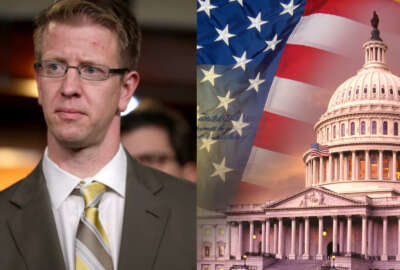The political battle takes shape: What it could mean for basic governmental operations
Both parties say a continuing resolution is inevitable; the only question is how long it will last.
Conventions over, the politicians are hammering away at one another. With the election looking close, questions arise over the next fiscal year budget and the timing for getting it actually enacted. WTOP Capitol Hill Correspondent Mitchell Miller shares details on the Federal Drive with Tom Temin.
Interview transcript:
Tom Temin
Well, we know there’s a CR; that’s a given. Both parties say that, but the shape and tone and timing of it could be really different depending on who wins.Mitchell Miller
Yeah, this is going to be a kind of different CR, all owing to the presidential election. Congress, as you know, comes back in about two weeks in the thick of this presidential race where each political party wants to make the other side look as bad as possible. And that always presents challenges as lawmakers try to carry out the basic work of approving federal funding. So as of right now, the House has approved seven of the 12 appropriations bills. The Senate has not approved any, though there has been some progress in the Senate Appropriations Committee. A continuing resolution is inevitable. But the question is, how long will it last? You have the House Freedom Caucus, which recently sent up a flare saying it wouldn’t go along with any CR that doesn’t include reforms in connection with non-citizens from voting, something that’s actually already prohibited by the federal government. But conservatives also want a CR to extend into 2025 in the belief that former President Trump, if he’s going to get elected, they don’t want to extend programs that are backed by Democrats — mainly domestic programs — for another year. The House and Senate Democrats want to do what is often done, which is try to get to a final agreement during the lame duck session, after a CR is initially agreed to, perhaps a shorter one. But of course, all this gets complicated because of the end of the fiscal year coming up just weeks before the election.Tom Temin
Alright, and well, then that’s a big if. The other big if is, of course, the policies that will ensue for the federal workplace and for the federal government — couldn’t have groups more widely divergent. Either it’s a red herring or a blueprint. I don’t know which color. The project 2025 keeps coming up.Mitchell Miller
Yeah, Project 2025 got a lot of attention last week at the Democratic Convention, with some speakers hauling out this big book of proposals that could affect federal agencies and federal workers. And as you know, this was put together by the Heritage Foundation and former Trump of administration officials as a possible blueprint, or at least a look ahead to the future, for a possible Trump administration. Setting aside the politics, there are some basic nuts and bolts that are included. One of them is Schedule F, which came into play during the Trump administration and then was rescinded by the Biden administration. It would, as you know, move some career senior executives out from under Title V civil service protections. And some of these career policy people could be treated along the lines of Schedule C appointees, and it would essentially be easier for an administration to get rid of them. Project 2025 also includes a lot of other proposals to make pay raises for more performance-related, standard tests for federal employment. And I think whether you like or dislike these ideas, it’s notable that these issues are getting attention during a presidential campaign, making the federal government less opaque, and it’s really going to cause a lot more attention on the federal government.Tom Temin
Yeah, the other big thing besides the Schedule F — there are bills right now for locality pay for returning to the office. They call it returning to work, which really sticks in the craw of feds, because they say they are working, they’re just not working downtown two days a week, or whatever the case might be. And so we’ll have to keep an eye on those. We’re speaking with WTOP Capitol Hill Correspondent Mitchell Miller, and you’ve also noticed some updates on federal agency efforts to reduce the office space, the so called underutilized space that they have to the tunes of millions of square feet. Right?Mitchell Miller
This touches on the issue that you were just talking about. Federal agencies have told the Office of Management and Budget that they’ve eliminated hundreds of thousands of square feet of office space, and it is going to go into the millions in the coming years. Virtually every major agency is reducing its imprint in various buildings in the Washington area and elsewhere across the country, and this has been something that many in Congress have been pushing for. They don’t want the federal government and taxpayers paying large sums of money to lease office space that goes unused. So just to give a few examples, the Department of Housing and Urban Development plans to reduce its federal office space by 60% within the next 15 years or so. The Energy Department, meanwhile, has outlined plans to get rid of more office building space than any other agency. The agency told the OMB that it plans to get rid of 3 million square feet of building space through 2027, so that’s coming up pretty quickly, and a lot of that would be consolidated here in the Washington area. And then you can just point to a variety of other agencies with all kinds of reduction plans. GSA said it reduced the federal footprint by more than 2 million square feet over the past decade, and they say that has saved hundreds of millions of dollars in operating and maintenance costs. So this is something that is going to obviously keep rolling forward. And then locally, of course, it has a big implication for the District of Columbia, because by one estimate, about a year ago, it was something along the lines of a reduction by 30% of the federal office space that’s occupied in DC. And of course, that has huge implications for the district and taxes, and what kind of revenue can be brought in, and then what’s going to happen with the spaces that are now empty, and how they are going to be reinvented.Tom Temin
They have the issue more intensely, I think locally, is leased space. And if you go through the canyons of Rosslyn and Crystal City, lots of leased space and then federally owned facilities right in Washington, none of them are really operating at stuffed capacity.Mitchell Miller
Right. It’s really just a huge, huge issue. And Mayor Bowser in DC has tried to put together some proposals for reinventing, as I said, some of these spaces, trying to convert them into residential areas, for example. But it’s very complicated because of the way some of these buildings are structured. And it’s not as easy as just flipping a few switches and changing a few pipes and doorways and saying, Okay, now this is an apartment building.Tom Temin
Right? It’d be kind of nice to havea few windows in Treasury if that location is ever available, but you’re on your own when it comes to the plumbing that was laid down in 1910 and then maybe 1810. You’re noticing a little bit of shoots of bipartisanship in the House with respect to the task force that’s looking at the assassination attempt on former President Trump, and you’re seeing Democrats and Republicans not at each other’s throats on that one.Mitchell Miller
This was one of the interesting things as the session in the House ended this summer, the vote to establish this new bipartisan Task Force. This was a real rarity. Not a single vote, 416 to zero to establish this task force. And the task force is now up and running, it’s got 13 members, as these bipartisan task forces often do. They have one more of the party in power. So you have seven Republicans and six Democrats. The chair of this task force is Mike Kelly, the congressman from Pennsylvania, who represents the area in Pennsylvania where the assassination attempt on former President Trump took place. And then the ranking Democrat is Colorado Democrat Jason Crow. They have also come out with various announcements together. They are very much working together. This is in complete contrast to what happened with the January 6 select committee. But they have already sent out demands and requests to major agencies for all kinds of information and any kind of communications related to the assassination attempt, and that includes to the Homeland Security secretary, to the head of the Secret Service, who is now Ronald Rowe, the attorney general at Justice and then the FBI director. And all of this happens as there’s more intense scrutiny of what happened, of course, in Pennsylvania. We learned late last week that the Secret Service has apparently put several secret service agents from the Pittsburgh field office on leave. There has been a big call for accountability from lawmakers from both sides for something to take place and not just have this glossed over. And I think we are going to see real reforms, because they say this needs to be taken care of quickly, especially since we’re really right in the middle of a presidential campaign.Tom Temin
Yeah, and sadly, if you look at assassinations and assassination attempts, they run to both parties. James Garfield and Lincoln were Republicans. John F Kennedy was a Democrat. And so I guess there’s equal concern, politics aside, on that particular topic.Mitchell Miller
Absolutely, and they hope to get a report out, by the way, by early December, but they also indicated they may have preliminary recommendations much earlier than that. We’ve already seen some changes with the Secret Service. For example, former President Trump now has a bulletproof, enclosed area that goes around him when he is at an outdoor rally. Previously that’s only been reserved for the current president, but this has now been extended to the former President Trump.Tom Temin
And I thought those were just to muffle the drummer going on there. And real quickly to the fortifications are going on a little bit in the Capitol building itself.Mitchell Miller
Right. This is something that I’ve noticed, and I’ve got to find out more about it, but you can’t help but notice that when you come into the US Capitol right now, there is work where they’re basically taking all of the doors around the Capitol, and they’re turning them into double doors, and they’re clearly adding a lot of electrical parts to make for security. And I think this is clearly a fallout from January 6, where you had a lot of these doors that people literally just broke down and busted through, not to mention the windows that they broke through. So you’ve had windows that have been fortified, and then all of these doors around the Capitol now have big electronic equipment around them, and you can tell that there is clearly a ramping up of the security all around the Capitol. Maintenance often happens at the Capitol when everybody is out of session, but this time, it looks like this is a very intense operation taking place, and it looks like all of these doors are going to be fully fortified in the coming weeks and months.Tom Temin
Well, let’s hope they don’t need them, but they’re there anyhow.
Copyright © 2024 Federal News Network. All rights reserved. This website is not intended for users located within the European Economic Area.
Daisy Thornton is Federal News Network’s digital managing editor. In addition to her editing responsibilities, she covers federal management, workforce and technology issues. She is also the commentary editor; email her your letters to the editor and pitches for contributed bylines.
Follow @dthorntonWFED






